
| Home | Contact Us | Site Map | Search |
 |
||||
|
|
|
|
|
| |
|
|
This file is provided for reference purposes only. It was current when it was produced, but it is no longer maintained and may now be out of date. Persons with disabilities having difficulty accessing information may contact us for assistance. For reliable, current information on this and other health topics, we recommend consulting the NIH Clinical Center at http://www.cc.nih.gov/.
|
|
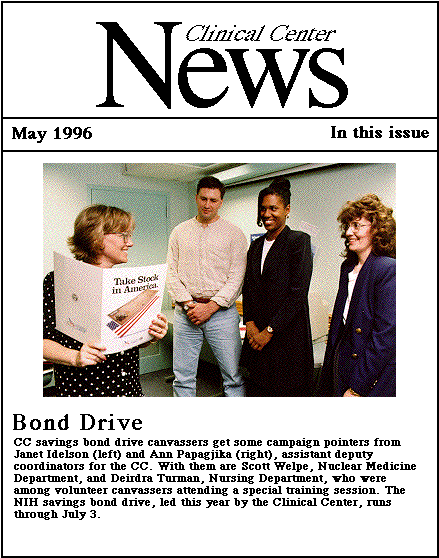
|
Clinical Center News, Building 10, Room 1C255, National Institutes of Health, Bethesda, Maryland 20892. (301) 496-2563. Fax: 402-2984. Published monthly for CC employees by the Office of Clinical Center Communications, Colleen Henrichsen, chief. News, articles ideas, calendar events, letters, and photographs are welcome. Deadline for submission is the second Monday of each month. |
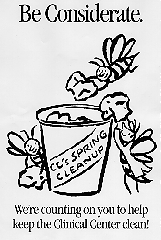
"Watch for our fax-back forms to report problem areas," say campaign coordinators. "We hope you will make copies of the fax forms and send the forms to housekeeping often so staffers can respond quickly to problem areas."
The Housekeeping and Fabric Care Department also has a new e-mail address for reporting areas that need attention. It's cc_clean@pop.cc.nih.gov.
Details on these and other department initiatives will be included in special
Cleanup Campaign bulletins that will be distributed throughout May.
"The Board of Governors will advise the NIH director and the Clinical Center director on all aspects of operations here, including budget, strategic plans, and annual programs, and will serve as the governing body for clinical activities," explains Dr. John Gallin, CC director.
"The first slate of board members will be appointed by HHS Secretary Shalala," Dr. Gallin adds. "And all subsequent appointments will be made by the NIH director." The 17-member board will include eight members from NIH and nine from the outside. "The non-NIH members will be selected on the basis of their knowledge and expertise in health-care governance and management, operations of large academic health centers, clinical research, and in areas important to the future development of the Clinical Center," Dr. Gallin says. The members from NIH will reflect broad representation of the institutes and centers with clinical programs here.
Major responsibilities also will include:
--oversight of a CC Medical Executive Committee;The change in how the CC is governed topped the list of recommendations contained in a report to HHS Secretary Shalala earlier this year. An Options Team empowered by Secretary Shalala scrutinized the CC's structure and organization throughout 1995 as part of Vice President Gore's Reinventing Government II initiative.
--evaluation of the CC director's performance and review of the administration's responsiveness to operational and budget goals;
--annual review of how well institutes and centers follow their annual operations plan for using CC resources; and
--evaluation of how the CC Board of Scientific Counselors review independent research conducted by CC investigators.
The CC historically has been managed by a series of NIH committees and groups. At press time, the initial slate of appointees was awaiting HHS approval.
Go to Board of Governors NIH News Advisory
But the presentation wasn't simply to satisfy the curiosity of those who'll be watching from across the street. "This is more than a public relations and public information effort," points out Janyce Hedetniemi, director of the NIH Office of Community Liaison, "it's policy implementation."
That's because the new research facility will be the first major project carried out under the NIH Master Plan approved in February by the National Capital Planning Commission. The commission's policy, Hedetniemi explains, stipulates community involvement. "Nothing will be built without the commission's concurrence, and they won't concur unless they are convinced that the community was not only involved, but also listened to and considered in planning."
During that April meeting, representatives from the project's developer, Boston Properties, and the design team, led by Zimmer Gunsul Frasca Partnership, talked to community members. "Both the developer and the architect made great points," Hedetniemi says, "demonstrating our sensitivity to the community, commitment to their involvement, and the need for community concurrence in projects."
Until the new master plan was adopted earlier this year, NIH had operated under one drafted in 1972. The plan was developed by the Facilities Planning and Programming Branch of the Division of Engineering Services. Hedetniemi's office developed the process for community involvement in the master plan and its projects. (by Sara Byars)
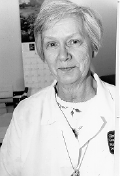 People like Rita White, Nursing Department. "I buy bonds for my granddaughter's
college education. She'll be seven this year. I like it because the bonds
go directly to her house, and it's easy to keep track of."
People like Rita White, Nursing Department. "I buy bonds for my granddaughter's
college education. She'll be seven this year. I like it because the bonds
go directly to her house, and it's easy to keep track of."
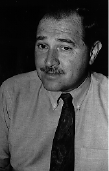 Jerry King, Medical Record Department, has another reason. "I buy bonds
because I have no discipline," he admits with a laugh. "It's an
automatic withdrawal made out in my son's name. It's his college fund."
Jerry King, Medical Record Department, has another reason. "I buy bonds
because I have no discipline," he admits with a laugh. "It's an
automatic withdrawal made out in my son's name. It's his college fund."
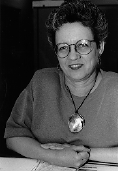 Gracie Millender, Outpatient Department, counts on bonds in the long term.
"Bonds are one tiny part of my retirement plan. I've been doing it
for about two years. It's a small amount taken out every month. It's harder
to cash a bond than to make a withdrawal from savings-bonds are tangible
things, so you think twice before cashing them in."
Gracie Millender, Outpatient Department, counts on bonds in the long term.
"Bonds are one tiny part of my retirement plan. I've been doing it
for about two years. It's a small amount taken out every month. It's harder
to cash a bond than to make a withdrawal from savings-bonds are tangible
things, so you think twice before cashing them in."
Brenda Butler, Outpatient Department, is a bond buyer, too. "I buy
bonds to make sure that my grandchildren will have a head start on their
college fund," she says. "That's my main purpose. It's a simple
way to save money. You don't see it so you don't miss it."
The NIH Savings Bond Campaign runs through July 3. The Clinical Center leads this year's campus-wide effort.
NIH employees staffing 29 booths will offer information on such topics as mental health, safety, exercise, ergonomics, advance directives, and prevention and control of common diseases. Booth sponsors from the CC include the NIH Blood Bank, Department of Transfusion Medicine; the NIH Marrow Donor Center; the Nursing Department, in cooperation with NHLBI (Cardiovascular and Pulmonary Health); the Rehabilitation Medicine Department (Back Care-When Lifting and at Leisure); the Bioethics Program (Your Health-Care Wishes); and the Nutrition Department (Calories Still Count).
Physician and humorist Steve Allen, Jr., will kick off the event at 10:30 a.m. on May 14 in Masur Auditorium. His topic is "Lighten Up-Keeping your Balance with Humor."
Sponsors are the Office of Disease Prevention in cooperation with the NIH institutes, centers, and divisions, the R&W, and the FDA. The event is an initiative of the Worksite Health Promotion Program. For details, call 496-2222.
Illness Across the Life Span: An Interdisciplinary Education Series, June 4, noon-1 p.m. Participants will learn more about the special needs, behaviors, and issues related to patient care for specific age groups. Call 496-1618 to register.
Poster space is limited to about 300, and principal investigators are encouraged to reduce the number of entries from the same lab by coordinating or combining similar presentations.
Application through the World Wide Web is now possible. Go to http://mantis.dcrt.nih.gov/festival/ for instructions. For details on the festival, contact Gregory Roa at the Visitor Information Center, 496-1776 or gr25v@nih.gov.
"A PICC is a very thin, flexible, plastic tube that looks almost like a piece of spaghetti," says Sue Lorenz, R.N. The catheter is inserted in an arm (peripheral) vein and threaded up to a main vein in the neck or chest. After proper placement is confirmed by x-ray, the line can be used both to administer drugs and to withdraw blood. This eliminates the need for repeated needle sticks. With appropriate care the catheters can remain comfortably in place for weeks to months, a benefit to patients who need long-term intravenous therapy.
Access to a main vein is vital in some forms of therapy. "Some chemotherapeutic
agents cannot be given into a peripheral vein because they are too irritating
and could actually damage the vein and make it unusable," says Lorenz.
Traditional central-access catheters must be inserted directly into a neck
or chest vein. Others must be surgically implanted. "Our patients are
happy to have this option," says Dr. Peter Eichacker, who is the medical
supervisor for PICC lines. "Their health-care providers in the various
institutes also seem pleased. Demand for these catheters is increasing dramatically."
For the past few years, the Diagnostic Radiology Department has placed PICCs in patients with difficult venous access. In such cases, the technologist must guide the catheter by fluoroscopy (radioactive dye). CCMD handles patients who don't have such complications.
PICCs are inserted by a staff of five specially trained CCMD nurses who also manage the lines, follow up with patients, and educate staff about the applications for these and other types of intravenous catheters. "The CCMD nursing staff are experts in line placement," says Lorenz. "We are available to answer questions about what type of line is best for a patient."
Staff have placed over 200 PICCs in the past year, according to Lorenz. More training is planned to accommodate the demand. An improvement project with CCMD and radiology will gather valuable data on PICC lines to help the Clinical Center and other institutions refine this service.
For more information or to schedule a PICC line insertion, call Debbie Gutierrez, R.N., at 5-2351. (by Sue Kendall)
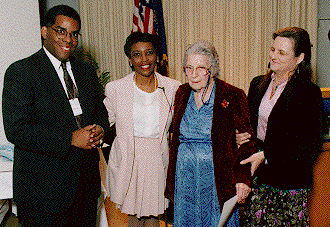 CC honors volunteers
CC honors volunteers
Sponsors for this year's Take Your Child to Work Day activities were the Clinical Center, the Office of Research Services, NIDR, and NIAAA, with support from NICHD and NLM.
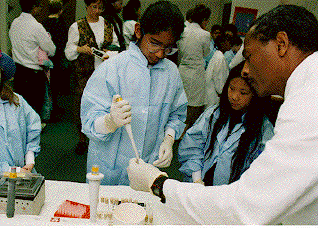 Using vials of apple juice, Clifton Moore, Clinical Pathology Department
medical technologist, demonstrates testing blood serum for mononucleosis.
Using vials of apple juice, Clifton Moore, Clinical Pathology Department
medical technologist, demonstrates testing blood serum for mononucleosis.
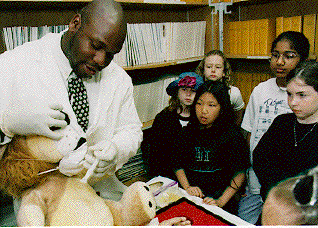 Richard Gourdine, Clinical Pathology Department phlebotomist, examines his
lion patient while discussing the relationship of germs to disease.
Richard Gourdine, Clinical Pathology Department phlebotomist, examines his
lion patient while discussing the relationship of germs to disease.
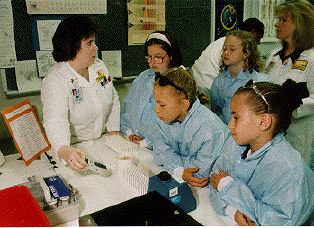 Maureen Sampson explains the bedside blood-glucose analyzer.
Maureen Sampson explains the bedside blood-glucose analyzer.
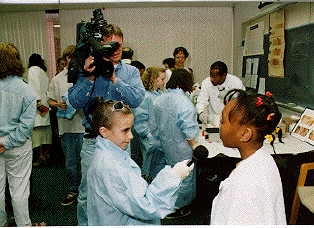 Christina Hall (left), visiting the Clinical Center with Cable News 21 reporter
Racine Hamilton, interviews Jina Jackson about her visit to NIH with her
grandmother.
Christina Hall (left), visiting the Clinical Center with Cable News 21 reporter
Racine Hamilton, interviews Jina Jackson about her visit to NIH with her
grandmother.
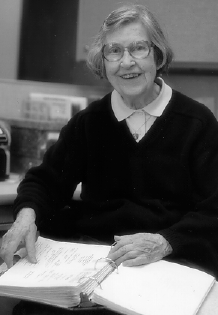 Delphine Moeller began work at the Clinical Center on May 2, 1955. She
remembers it as if it were yesterday.
Delphine Moeller began work at the Clinical Center on May 2, 1955. She
remembers it as if it were yesterday. She also remembers almost every person who ever worked in the Pharmacy Department since her transfer there in 1960. Their names and addresses on index cards fill two file boxes. Details are important. In pharmacy, and in life.
Details such as why your African violets won't flower and what astronomical wonders are currently on display in the night sky. The next day she'll pass on an article backing up her advice on the violets and jot down the Smithsonian phone number from memory so you can further explore the constellations.
"Do you know what I was doing at 1 a.m.?" she asks. "Standing in my yard, looking at the new comet, Hyakutake. I figure that if it won't be back for 10,000 years, I should take a look at it."
Moeller, 85, retired April 1 after a CC career that covered nearly four decades. When she moved to Maryland in 1941, Old Georgetown Road was two country lanes. And renting a house along the C&O canal cost only $35 a month.
When jobs were scarce during the Depression, Moeller learned to type in her spare time. Those self-taught skills were put to the test in 1955 when she arrived at NIH looking for work. Moeller's husband, a 41-year-old engineer and avid speed skater, had died of a heart attack leaving her alone with the daunting task of raising three children. In a hot Quonset hut, where building 31 stands today, Moeller passed her typing test and landed a government job. She never left.
"I went to work when the Clinical Center was a beautiful new building with pools and azaleas and marble benches. Work was mixed with fun then, and there was no worry about security," she adds.
Over the years, Moeller has been secretary to each of the CC's three pharmacy chiefs: Milton Skolaut, Joseph Gallelli, and Charles Daniels, whom she remembers from his days as hospital pharmacy resident in 1975.
"When I was a resident, Mrs. Moeller was already an institution in the Pharmacy Department. She knew how to find anything that was written, or even referred to, by anyone in pharmacy," Daniels recalls. "Amazingly, she still has that knack in 1996. There was nothing that she could not find, regardless of what key words I asked about. In preparing for her last week at work she kept reminding me of things that needed to be tended to by her successor. She was worried that we may have difficulty finding important information, and was concerned about the department to her last day. She has uncommon dedication to the NIH."
Dr. Skolaut, who left the Clinical Center more than 25 years ago-he now lives in North Carolina-felt so strongly about her work, that he wrote a letter thanking her and wishing her luck in her retirement.
During Moeller's last week on the job, she offered coffee and cookies to the streams of people dropping in to say, so-long. Pictures from the past 85 years are scattered across her work space showing all phases of her life. There's one of Moeller as a member of her high school basketball team-undefeated Michigan state champs in 1928-29. She still writes to two of her teammates. Another picture shows Moeller with her badminton partners.
"I couldn't get enough badminton in those days," she laughs. "We used to play badminton here on the 14th floor. And many of the departments had basketball teams that we would cheer on. Serious work was mixed with fun. It was an interesting place to work. I never thought of going anywhere else."
And for future plans, well, there's her garden to tend, books to read, art exhibits to view, and the achievements of her grandchildren to record.
And then, there's that comet. (by Laura Bradbard)
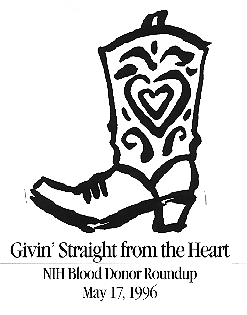 Blood bank roundup spotlights volunteers
Blood bank roundup spotlights volunteers To be recognized for making 50-74 research apheresis donations are Helen Balling-Wenzel, John Beach, Janet Brogdon, Charles Byrne, Mitchell Harris, Rodney Malone, Frank Nice, Thomasine Smith-Twyman, John Solyst, Stephen Stampfer, and Ray Williams. Those to be honored for 75-100 donations are Herman Bell, Brenda Butler, Juanita Hall, Solange Hess, Eugene Lane, Michael Nauman, and Douglas Seeley. James Bell and Johnny Carter will be recognized for more than 100 donations.
To be commended for 20 years as a whole-blood donor are Albert Baukal, Anna Cooke, John Ewell, Carter Gibson, Judith Greenberg, Steven Groban, Richard Hodes, Carolyn McHale, Bonnie McKenzie, Benjamin Perry, Erik Pottala, Constance Raab, Jeffrey Schriver, Timothy Sullivan, and Michelle White.
To receive 25-year awards are Roger Dahlen, Mary Lee Dante, Jerry Elliott, Stephen Filbert, Anne Hardman, Betty Hiller, Elaine Lee, Carol Letendre, Marc Lewis, Jenean McKay, Peter McPhie, Newlin Morgan, Sanda Rife, Joan Shariat, Raymond Summers, Gary Thompson, Charles Thornton, J. Emmett Ward, and Shun-Ichi Yamaguchi.
Honors for 30 years will go to David Blessley, Frederic Mushinski, and Michael Oxman. Jon Halverson, James Ries, and John Wolff will receive awards for 35 years, and Charles Evans and Milton Whittington will receive 40-year awards.
Ten-gallon awards will go to Lawrence Dale, Benjamin Fulton, Steven Galen, Aspandiar Katki, Thomas Lewis, Philip Marcus, Ella Myers, Erik Pottala, Joan Shariat, Richard Sherbert, Richard Stewart, B.J. Stone, and Raymond Summers.
Joining the Hall of Fame for 100 donations are Joel Avigan, Elizabeth Diffley, and Shun-Ichi Yamaguchi.
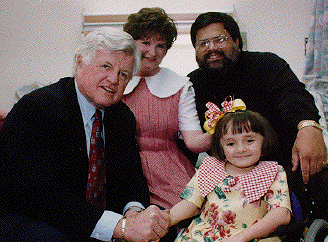 CC visitor
CC visitor
Comments?
webmaster@cc.nih.gov
National Institutes of Health (NIH)
Last modified 5/24/96

|
|